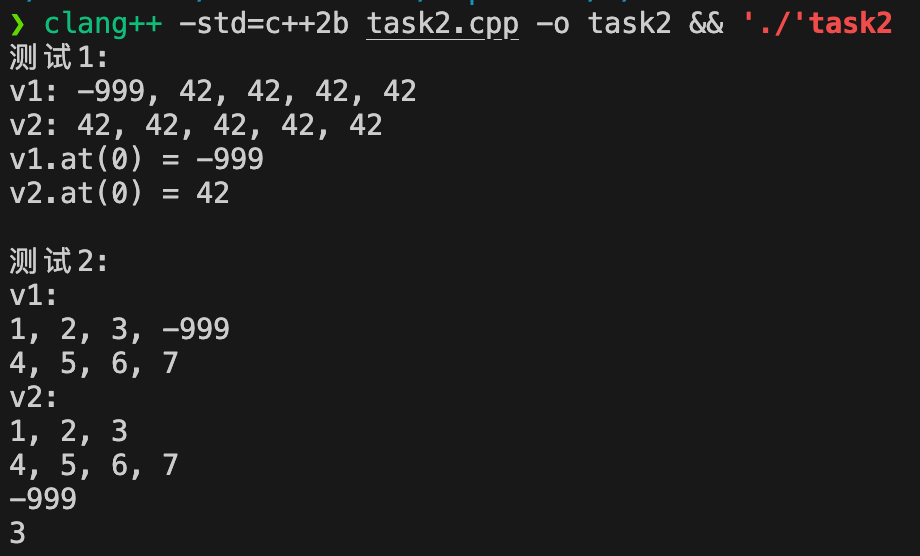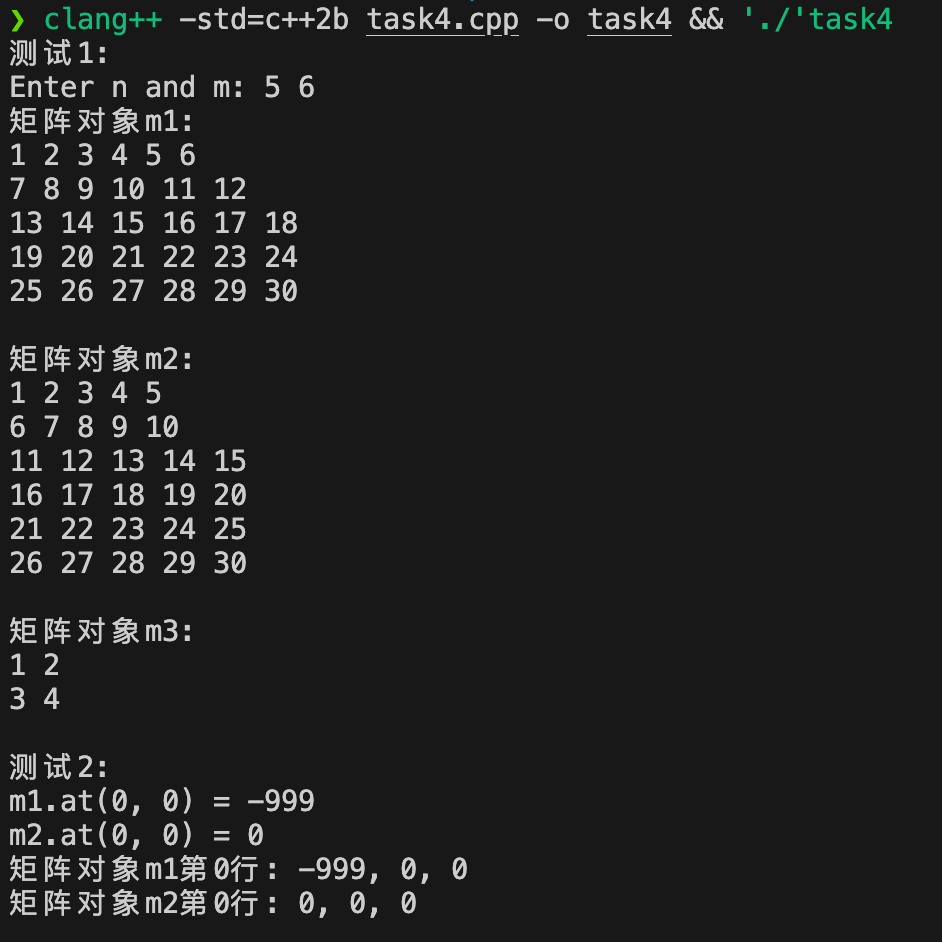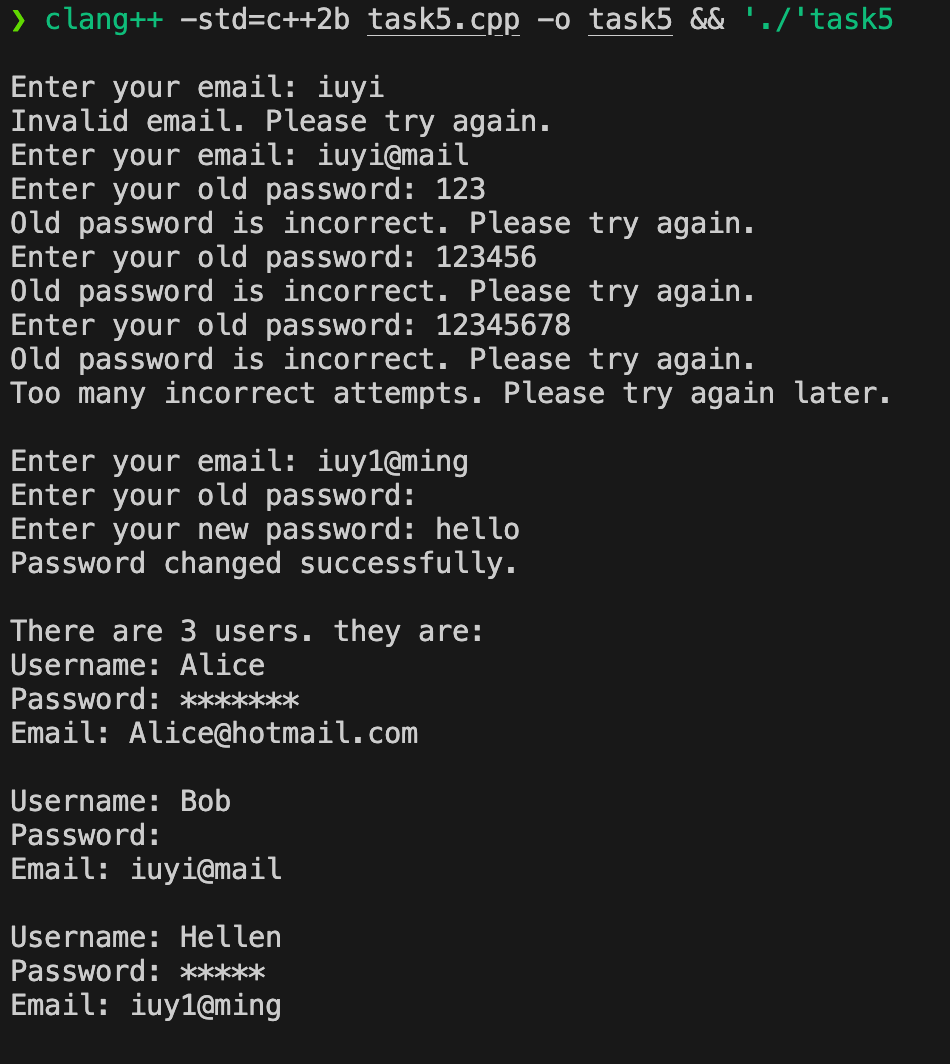实验3 类和对象_基础编程2
实验3 类和对象_基础编程2
实验任务 1
// button.hpp
#pragma once
#include <iostream>
#include <string>
using std::cout;
using std::string;
// 按钮类
class Button {
public:
Button(const string &text);
string get_label() const;
void click();
private:
string label;
};
Button::Button(const string &text) : label{text} {}
inline string Button::get_label() const { return label; }
void Button::click() { cout << "Button '" << label << "' clicked\n"; }
// window.hpp
#pragma once
#include "button.hpp"
#include <iostream>
#include <vector>
using std::cout;
using std::endl;
using std::vector;
// 窗口类
class Window {
public:
Window(const string &win_title);
void display() const;
void close();
void add_button(const string &label);
private:
string title;
vector<Button> buttons;
};
Window::Window(const string &win_title) : title{win_title} {
buttons.push_back(Button("close"));
}
inline void Window::display() const {
string s(40, '*');
cout << s << endl;
cout << "window title: " << title << endl;
cout << "It has " << buttons.size() << " buttons: " << endl;
for (const auto &i : buttons)
cout << i.get_label() << " button" << endl;
cout << s << endl;
}
void Window::close() {
cout << "close window '" << title << "'" << endl;
buttons.at(0).click();
}
void Window::add_button(const string &label) {
buttons.push_back(Button(label));
}
// task1.cpp
#include "window.hpp"
#include <iostream>
using std::cin;
using std::cout;
void test() {
Window w1("new window");
w1.add_button("maximize");
w1.display();
w1.close();
}
int main() {
cout << "用组合类模拟简单GUI:\n";
test();
}

-
自定义的类:
Button类:表示按钮。
Window类:表示窗口。
使用到的标准库类:
std::string:表示字符串。
std::vector:表示动态数组。
std::iostream:用于输入输出操作。
类与类之间的组合关系:
Window类中包含了一个vector<Button>,表示窗口中包含多个按钮,这是一种组合关系。
Window类的构造函数中创建了一个Button对象,并将其添加到buttons向量中。 -
不适合,
Button::click()这个函数可能要修改内部状态(如点击计数),所以不适合加 const。 -
创建一个名为
s的字符串对象,该字符串由 40 个字符*组成,
即****************************************。
实验任务 2
#include <iostream>
#include <vector>
using namespace std;
void output1(const vector<int> &v) {
for (auto &i : v)
cout << i << ", ";
cout << "\b\b \n";
}
void output2(const vector<vector<int>> v) {
for (auto &i : v) {
for (auto &j : i)
cout << j << ", ";
cout << "\b\b \n";
}
}
void test1() {
vector<int> v1(5, 42);
const vector<int> v2(v1);
v1.at(0) = -999;
cout << "v1: ";
output1(v1);
cout << "v2: ";
output1(v2);
cout << "v1.at(0) = " << v1.at(0) << endl;
cout << "v2.at(0) = " << v2.at(0) << endl;
}
void test2() {
vector<vector<int>> v1{{1, 2, 3}, {4, 5, 6, 7}};
const vector<vector<int>> v2(v1);
v1.at(0).push_back(-999);
cout << "v1: \n";
output2(v1);
cout << "v2: \n";
output2(v2);
vector<int> t1 = v1.at(0);
cout << t1.at(t1.size() - 1) << endl;
const vector<int> t2 = v2.at(0);
cout << t2.at(t2.size() - 1) << endl;
}
int main() {
cout << "测试1:\n";
test1();
cout << "\n测试2:\n";
test2();
}

-
通过创建两个向量
v1和v2,并对v1进行修改,展示了v1的变化并不会影响到v2,因为v2是在v1的创建时就已经拷贝了当前的值。 -
展示如何创建和操作二维 vector,特别是如何创建其副本以及如何对原始 vector 进行修改而不影响常量副本。
-
分别从一个可修改的二维向量
v1和一个常量二维向量v2中提取并输出最后一个元素。 -
vector 的复制构造函数实现了 深复制。vector 的 at() 方法应该提供一个 const 成员函数作为接口,否则用户将无法在 const vector 对象上调用该方法。
实验任务 3
// vectorInt.hpp
#pragma once
#include <cassert>
#include <iostream>
using std::cout;
using std::endl;
// 动态int数组对象类
class vectorInt {
public:
vectorInt(int n);
vectorInt(int n, int value);
vectorInt(const vectorInt &vi);
~vectorInt();
int &at(int index);
const int &at(int index) const;
vectorInt &assign(const vectorInt &v);
int get_size() const;
private:
int size;
int *ptr; // ptr指向包含size个int的数组
};
vectorInt::vectorInt(int n) : size{n}, ptr{new int[size]} {}
vectorInt::vectorInt(int n, int value) : size{n}, ptr{new int[size]} {
for (auto i = 0; i < size; ++i)
ptr[i] = value;
}
vectorInt::vectorInt(const vectorInt &vi) : size{vi.size}, ptr{new int[size]} {
for (auto i = 0; i < size; ++i)
ptr[i] = vi.ptr[i];
}
vectorInt::~vectorInt() { delete[] ptr; }
const int &vectorInt::at(int index) const {
assert(index >= 0 && index < size);
return ptr[index];
}
int &vectorInt::at(int index) {
assert(index >= 0 && index < size);
return ptr[index];
}
vectorInt &vectorInt::assign(const vectorInt &v) {
delete[] ptr; // 释放对象中ptr原来指向的资源
size = v.size;
ptr = new int[size];
for (int i = 0; i < size; ++i)
ptr[i] = v.ptr[i];
return *this;
}
int vectorInt::get_size() const { return size; }
// task3.cpp
#include "vectorInt.hpp"
#include <iostream>
using std::cin;
using std::cout;
void output(const vectorInt &vi) {
for (auto i = 0; i < vi.get_size(); ++i)
cout << vi.at(i) << ", ";
cout << "\b\b \n";
}
void test1() {
int n;
cout << "Enter n: ";
cin >> n;
vectorInt x1(n);
for (auto i = 0; i < n; ++i)
x1.at(i) = i * i;
cout << "x1: ";
output(x1);
vectorInt x2(n, 42);
vectorInt x3(x2);
x2.at(0) = -999;
cout << "x2: ";
output(x2);
cout << "x3: ";
output(x3);
}
void test2() {
const vectorInt x(5, 42);
vectorInt y(10, 0);
cout << "y: ";
output(y);
y.assign(x);
cout << "y: ";
output(y);
cout << "x.at(0) = " << x.at(0) << endl;
cout << "y.at(0) = " << y.at(0) << endl;
}
int main() {
cout << "测试1: \n";
test1();
cout << "\n测试2: \n";
test2();
}

-
深复制
-
不能

有潜在安全隐患,const 对象的值不应该可以被修改。 -
返回值类型可以改成
vectorInt。不过,如果将返回值类型改为vectorInt,需要注意返回的对象可能会导致性能上的开销,因为将会涉及到对象的复制。
实验任务 4
// matrix.hpp
#pragma once
#include <cassert>
#include <iostream>
using std::cout;
using std::endl;
// 类Matrix的声明
class Matrix {
public:
Matrix(int n, int m); // 构造函数,构造一个n*m的矩阵, 初始值为value
Matrix(int n); // 构造函数,构造一个n*n的矩阵, 初始值为value
Matrix(const Matrix &x); // 复制构造函数, 使用已有的矩阵X构造
~Matrix();
void set(const double *pvalue); // 用pvalue指向的连续内存块数据按行为矩阵赋值
void clear(); // 把矩阵对象的值置0
const double &at(int i, int j) const; // 返回矩阵对象索引(i,j)的元素const引用
double &at(int i, int j); // 返回矩阵对象索引(i,j)的元素引用
int get_lines() const; // 返回矩阵对象行数
int get_cols() const; // 返回矩阵对象列数
void display() const; // 按行显示矩阵对象元素值
private:
int lines; // 矩阵对象内元素行数
int cols; // 矩阵对象内元素列数
double *ptr;
};
// 类Matrix的实现:待补足
Matrix::Matrix(int n, int m) : lines(n), cols(m) {
ptr = new double[n * m];
clear();
}
Matrix::Matrix(int n) : Matrix(n, n) {}
Matrix::Matrix(const Matrix &x) : lines(x.lines), cols(x.cols) {
ptr = new double[lines * cols];
for (int i = 0; i < lines * cols; i++)
ptr[i] = x.ptr[i];
}
Matrix::~Matrix() {
delete[] ptr;
}
void Matrix::set(const double *pvalue) {
for (int i = 0; i < lines * cols; i++)
ptr[i] = pvalue[i];
}
void Matrix::clear() {
for (int i = 0; i < lines * cols; i++)
ptr[i] = 0;
}
const double &Matrix::at(int i, int j) const {
assert(i >= 0 && i < lines && j >= 0 && j < cols);
return ptr[i * cols + j];
}
double &Matrix::at(int i, int j) {
assert(i >= 0 && i < lines && j >= 0 && j < cols);
return ptr[i * cols + j];
}
int Matrix::get_lines() const {
return lines;
}
int Matrix::get_cols() const {
return cols;
}
void Matrix::display() const {
for (int i = 0; i < lines; i++) {
for (int j = 0; j < cols; j++) {
cout << ptr[i * cols + j] << " ";
}
cout << endl;
}
}
// task4.cpp
#include "matrix.hpp"
#include <cassert>
#include <iostream>
#include <numeric>
using std::cin;
using std::cout;
using std::endl;
const int N = 1000;
// 输出矩阵对象索引为index所在行的所有元素
void output(const Matrix &m, int index) {
assert(index >= 0 && index < m.get_lines());
for (auto j = 0; j < m.get_cols(); ++j)
cout << m.at(index, j) << ", ";
cout << "\b\b \n";
}
void test1() {
double x[1000];
std::iota(x, x + N, 1); // 用1到N初始化数组x
int n, m;
cout << "Enter n and m: ";
cin >> n >> m;
Matrix m1(n, m); // 创建矩阵对象m1, 大小n×m
m1.set(x); // 用一维数组x的值按行为矩阵m1赋值
Matrix m2(m, n); // 创建矩阵对象m1, 大小m×n
m2.set(x); // 用一维数组x的值按行为矩阵m1赋值
Matrix m3(2); // 创建一个2×2矩阵对象
m3.set(x); // 用一维数组x的值按行为矩阵m4赋值
cout << "矩阵对象m1: \n";
m1.display();
cout << endl;
cout << "矩阵对象m2: \n";
m2.display();
cout << endl;
cout << "矩阵对象m3: \n";
m3.display();
cout << endl;
}
void test2() {
Matrix m1(2, 3);
m1.clear();
const Matrix m2(m1);
m1.at(0, 0) = -999;
cout << "m1.at(0, 0) = " << m1.at(0, 0) << endl;
cout << "m2.at(0, 0) = " << m2.at(0, 0) << endl;
cout << "矩阵对象m1第0行: ";
output(m1, 0);
cout << "矩阵对象m2第0行: ";
output(m2, 0);
}
int main() {
cout << "测试1: \n";
test1();
cout << "测试2: \n";
test2();
}

实验任务 5
// user.hpp
#include <iostream>
#include <string>
class User {
private:
std::string name, password, email;
public:
User(std::string name, std::string password = "", std::string email = "")
: name(name), password(password), email(email) {}
void set_email() {
while (true) {
std::cout << "Enter your email: ";
std::getline(std::cin, email);
if (email.find('@') != std::string::npos) {
break;
} else {
std::cout << "Invalid email. Please try again." << std::endl;
}
}
}
void change_password() {
std::string old_password;
for (int attempt = 0; attempt < 3; ++attempt) {
std::cout << "Enter your old password: ";
std::getline(std::cin, old_password);
if (old_password == password) {
std::cout << "Enter your new password: ";
std::getline(std::cin, password);
std::cout << "Password changed successfully." << std::endl;
return;
} else {
std::cout << "Old password is incorrect. Please try again."
<< std::endl;
}
}
std::cout << "Too many incorrect attempts. Please try again later."
<< std::endl;
}
void display() {
std::cout << "Username: " << name << std::endl;
std::cout << "Password: " << std::string(password.length(), '*')
<< std::endl;
std::cout << "Email: " << email << std::endl;
}
};
// task5.cpp
#include "user.hpp"
#include <iostream>
#include <string>
#include <vector>
using std::cin;
using std::cout;
using std::endl;
using std::string;
using std::vector;
void test() {
vector<User> user_lst;
User u1("Alice", "2024113", "Alice@hotmail.com");
user_lst.push_back(u1);
cout << endl;
User u2("Bob");
u2.set_email();
u2.change_password();
user_lst.push_back(u2);
cout << endl;
User u3("Hellen");
u3.set_email();
u3.change_password();
user_lst.push_back(u3);
cout << endl;
cout << "There are " << user_lst.size() << " users. they are: " << endl;
for (auto &i : user_lst) {
i.display();
cout << endl;
}
}
int main() { test(); }

实验任务 6
...

